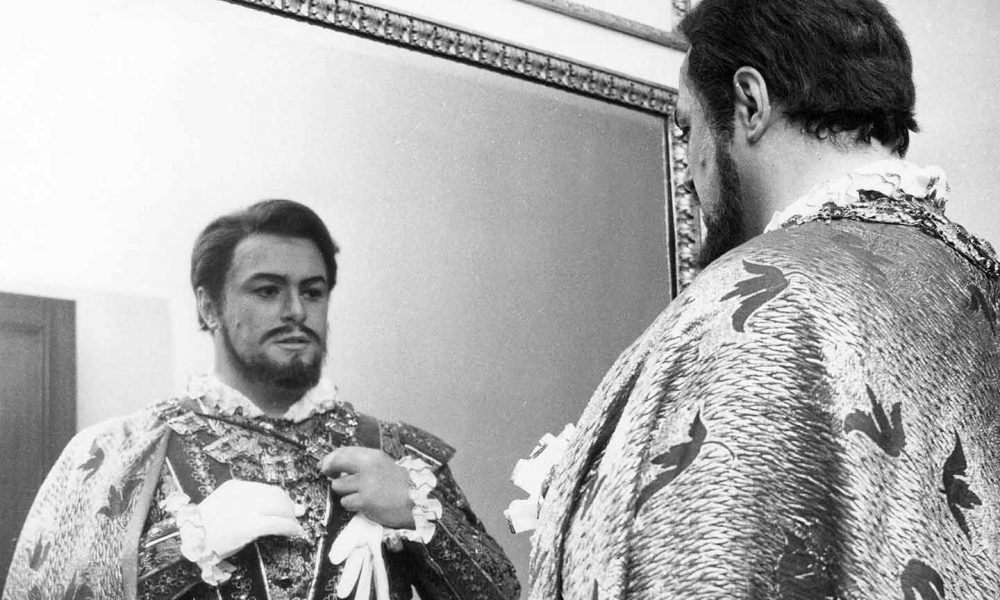Pavarotti: Essential Early Recordings Including ‘Nessun Dorma!’
Essential recordings from the first decade of Pavarotti’s 45 year recording career with Decca – an era of Puccini, Donizetti and Verdi.

Luciano Pavarotti enjoyed a 45-year recording career with Decca, and the result is a unique musical legacy. We explore the first decade of this relationship, an era of Puccini, Donizetti, and Verdi, and feature essential recordings, including ‘Nessun Dorma!’ from Puccini’s Turandot. His voice’s rich character was there from the start, as these early recordings vividly demonstrate. However many tenors one listens to, and indeed loves, there’s always a special excitement and security to be encountered in hearing Pavarotti’s distinctive and individual early performances.
Listen to the Best of Pavarotti on Apple Music and Spotify.
Pavarotti: What made him so special?
For many years Luciano Pavarotti represented to the wider popular imagination not only the tenor voice but also the art of opera itself. It was after the 1990 FIFA World Cup in Italy, and the Three Tenors concert which followed, that he assumed his position as the most famous operatic artist of his day, with a gigantic worldwide following including millions for whom opera was otherwise a closed book. But by then, Pavarotti was already nearly three decades into a career that had seen him headline at the world’s major opera houses. In terms of prestige and fame, no other Italian tenor of his time could touch him.
What made him so special? There was a great personality, of course – one to which the broadest public could easily respond. But above all, there was the voice – a special tenor voice in the classic Italian tradition which, on disc, goes back to Enrico Caruso, but which has been an essential part of Italian musical culture for centuries. It may have proved controversial when conductor Herbert von Karajan apparently said that Pavarotti was greater than Caruso, but in terms of his extraordinary fame and public appeal, the comment was just.
Pavarotti’s tone combined limitless vitality with an essential warmth and power, and its quality proved remarkably consistent throughout the course of a long and challenging career. Obviously, he knew what he was doing with his instrument, taking great pains to ensure its longevity. His roles, of course, changed over the years. He began as a lyric tenor, exploring the Italian repertory – La Bohème, Rigoletto, Lucia di Lammermoor, La Traviata – plus some bel canto specialties. Then gradually, as the voice developed, he moved into heavier spinto (or ‘pushed’) assignments – Un Ballo in Maschera, Don Carlos, La Gioconda, Aida, and even (in concert only) taking on the huge dramatic challenge of Otello.
The voice’s rich character, though, was there from the start, as these essential early recordings vividly demonstrate. Pavarotti’s was a spontaneous, natural art that responded deeply to the music, delivering it with a complex vocal texture and invariably shining on its glowing surface. However many tenors one listens to, and indeed loves, there’s always a special excitement and security to be encountered in hearing Pavarotti’s early performances, which remain as distinctive and individual as anything he ever set down on disc.
Bellini: Beatrice di Tenda Act 2 ‘Al Tuo Fallo Ammenda Festi’
This 1966 recording of Bellini’s rarely performed work marks Pavarotti’s first complete studio opera. Beatrice (Joan Sutherland) is married to the cruel tyrant Filippo, Duke of Milan (Cornelius Opthof), who wants to dispose of her – his excuse is provided when Orombello (Pavarotti) admits to the Duke’s lover, Agnese (Josephine Veasey), that he is in love with Beatrice. From this point, both he and she are doomed. In this moving quintet, Beatrice’s trial is underway, and Orombello, crippled by torture, has been brought in to seal her fate – already Pavarotti makes his distinctive vocal presence felt with the keen focus of his diction and the energy of his phrasing in this early recording.
Donizetti: La Fille du Régiment Act 1 ‘Le Camarade Est Amoureux’
Joan Sutherland was nominally the star of Donizetti’s military comedy when she brought it back to Covent Garden after 90 years’ absence in 1966, and would later (in 1972) return it to the Met. In between, in 1967, she made this marvelous recording. It fell to Pavarotti, however, to sing the famous nine consecutive top Cs in the showcase aria ‘Pour Mon Ame,’ and he did not disappoint. His technical feat established him as the “King of the High Cs” (as he was instantly dubbed). Brought up by an entire regiment of soldiers, Marie has fallen for Tyrolean peasant Tonio (Pavarotti), who joins up just to remain close to her. His prodigious vocal feat, incidentally, begins roughly four minutes in.
Donizetti: L’Elisir d’Amore Act 2 ‘Una Furtive Lagrima’
Pavarotti took to operatic comedy like a duck to water, and the role of the dumb but lovable peasant Nemorino in L’Elisir d’Amore remained with him for many years. He first sang it on an Australian tour with Sutherland in 1965, and appeared in the role at Covent Garden as late as 1990 and at the Met in 1998. In the comic, sentimental plot, Pavarotti plays the simple young farmer Nemorino, who is in love with the rich landowner Adina. But his shyness and her fickleness have made him despair of ever winning her affection. By the last act, however, he has noticed a change in her manner and, realizing that she has fallen for him, vows that he could ask for nothing more.
Verdi: Rigoletto Act 3 ‘La Donna è Mobile’
Pavarotti sang the Duke in Rigoletto many times, from his early days well into his maturity as a singer, and perhaps most notably of all in a film version directed by Jean-Pierre Ponnelle. Based on Victor Hugo’s once-banned drama Le Roi S’Amuse, the opera takes place around the corrupt court of a Renaissance Duke of Mantua. The cynical young nobleman sings the famous ‘La Donna è Mobile’ (‘Women are fickle’) to pass the time as he awaits the appearance of the latest girl to arouse his interest. Pavarotti’s liquid flow and his ease in reaching high notes are once again to the fore, as is his virile vocal manner in this early recording.
Puccini: Turandot Act 3 ‘Nessun Dorma!’
‘Nessun Dorma!’ has arguably become the most famous of all operatic arias, largely as a result of Pavarotti’s performance of it at umpteen events and arenas following its use as the theme song of the BBC’s 1990 FIFA World Cup coverage. Pavarotti’s interpretation on Zubin Mehta’s 1972 essential recording, remains the benchmark by which all others are measured. An unknown prince has succeeded in answering the three riddles of Princess Turandot and so has won her hand in marriage. But the prince offers to die at dawn if Turandot can discover his name before then. He listens to Turandot’s latest decree – no one shall sleep this night in Peking – then looks forward to his victory at dawn.
Puccini: La Bohème Act 1 ‘O Soave Fanciulla’
Rodolfo in Puccini’s La Bohème was a significant role for Pavarotti. He debuted as the young, unsuccessful writer in Reggio Emilia in 1961; two years later, he took over the role from an indisposed Giuseppe Di Stefano at Covent Garden – an event that led to his crucial relationship with Decca. His 1972 recording under Herbert von Karajan remains a classic early recording, and also recalls his special association with fellow citizen of Modena, Mirella Freni. At this stage in the opera, Rodolfo sends his friends off to the Café Momus, where he and Mimì will shortly join them – but not before the two lovers have declared their mutual affection in ‘O Soave Fanciulla.’
Bellini: I Puritani Act 3 ‘Vieni, Vieni Fra Questa Braccia’
Bellini’s bel canto classic – a tale of political enmity, personal betrayal, and madness set during the English Civil War near Plymouth – proved congenial territory for Pavarotti in his younger days, when his high notes soared with seemingly effortless ease. The role of Arturo contains some of the highest of all. In the final act, the errant hero returns to his beloved, bringing not only her reason back, but often bringing the house down, too, as the tenor goes for his top Fs. It’s a feat that Pavarotti achieves remarkably in his 1973 recording, maintaining a perfect, expressive line all the while.
Puccini: Madama Butterfly Act 1 ‘Vogliatemi Bene’
Puccini’s Madama Butterfly is set in Japan at the beginning of this century. In the first act of the opera, Lieutenant Pinkerton of the US Navy lightly marries Cio-Cio-San, a 15-year-old geisha known also as Madama Butterfly. Left alone after the wedding ceremony, Pinkerton and Butterfly begin their exquisite love duet as the evening gives way to night. Pinkerton is a role many top tenors shy away from in the theatre – there’s not a lot to do, and the character is unlikeable – but on disc Pavarotti gives it his passionate all, partnered once again by Freni and accompanied by Karajan.
Donizetti: La Favorita Act 4 ‘Spirto Gentil’
Originally written as a French grand opéra in 1840, Donizetti’s La Favorita is regularly performed in Italian translation, as in this 1974 recording. Set in Castile, in the 1340s, the novitiate Fernando falls in love with a beautiful woman ignorant of the fact that she is the king’s mistress. Leaving the monastery to pursue her, he finds himself publicly dishonored on account of their relationship. Returning to his calling, he tries to expunge all memory of her in the aria ‘Spirto Gentil.’ Pavarotti’s ability to shape a line and fill it with vibrant tone is particularly evident in this early recording.
Verdi: Requiem, ‘Ingemisco’ from the ‘Dies Irae’
The tenor line in Verdi’s proudly operatic Requiem is a touchstone for fine singing. Sensitivity and immense skill are required to negotiate the expressive melody line in the solo ‘Ingemisco’ part of the lengthy ‘Dies Irae’ sequence. Many Italian tenors include the Requiem as part of their standard repertoire, and Pavarotti’s version – recorded in Vienna under Georg Solti with an all-star line-up in 1967 – allows him to demonstrate control, power, and musicality, all at once.










